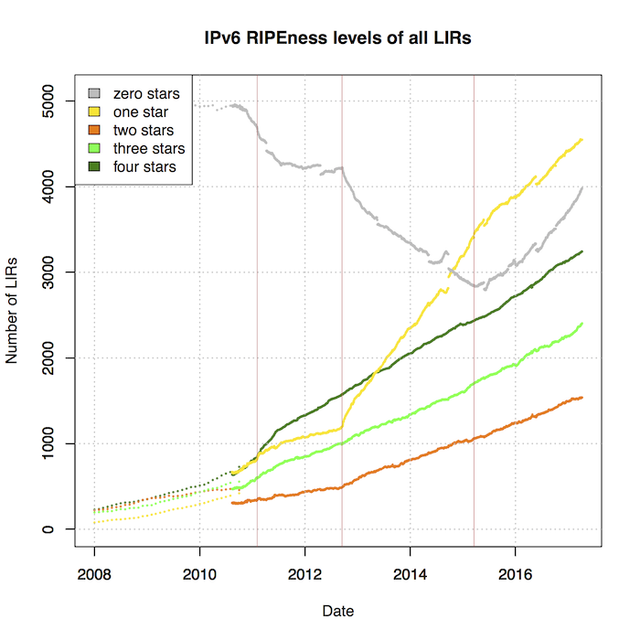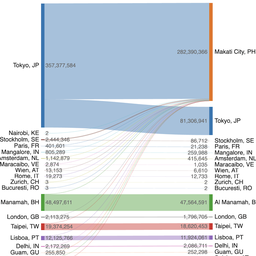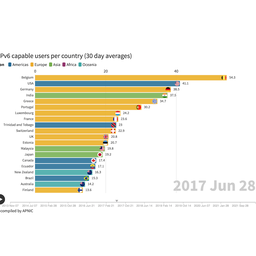In 2010, we introduced IPv6 RIPEness to recognise Local Internet Registries (LIRs) in the RIPE NCC service region that had begun deploying IPv6. Seven years later, we looked at how the IPv6 RIPEness level of the RIPE NCC membership evolved over time.
The IPv6 RIPEness system awards LIRs with up to five stars for each measurable step towards IPv6 deployment. As described in this article, every LIR can reach four-star RIPEness by requesting IPv6 space, registering a route object, requesting reverse DNS and announcing the IPv6 space in BGP. A fifth star was introduced in 2013 to measure actual IPv6 deployments.
In previous articles we looked at the present state and compared how the LIRs of different age groups were doing. Now we look at it from another angle: how did the IPv6 RIPEness level of the RIPE NCC membership as a whole evolve as a function of time? Because the sampling methodology of the fifth star makes this more difficult to reach for smaller LIRs, we restricted the analysis to the first four stars, so that each LIR has equal opportunities to be included and counted. Reaching four-star IPv6 RIPEness is entirely in an LIR's own hands.

In Figure 1, we plot the number of LIRs with zero, one, two, three and four stars of IPv6 RIPEness respectively for each day since we started with IPv6 RIPEness. We also have monthly data points for the years 2008 and 2009 as well as the first half of 2010; these were computed retroactively from archived data.
The evolution of IPv6 RIPEness shown in Figure 1 is characterised by four time periods, marked and delineated by the vertical red lines:
- August 2010 - July 2011. Running up to and immediately following the day IANA handed out the last of the unallocated IPv4 /8s to the RIRs (3 February 2011), the number of four-star LIRs was rising rapidly. Members who realised it was time to act on IPv6 took the steps that brought them four-star IPv6 RIPEness.
- July 2011 - September 2012. After the initial surge, growth in all IPv6 RIPEness categories slowed down in the second half of 2011. Growth continued at these levels, with the four-star category being the most populated one, until September 2012.
- September 2012 - March 2015. The day the RIPE NCC's IPv4 pool (first) fell to the level of one /8 marks a turning point in the evolution of IPv6 RIPEness. In an effort to promote IPv6, stimulate deployment by LIRs, the IPv4 policy for allocations from the last /8 required LIRs to hold an IPv6 allocation, either from the RIPE NCC or from another LIR, before they could get the final /22 of IPv4 space. Because of this requirement, we see a sharp increase in the growth rate of one-star IPv6 RIPEness. Both new and existing LIRs who were in need of IPv4, now had to obtain IPv6 space and thus scored the first star of IPv6 RIPEness. Two-star IPv6 RIPEness picked up growth as well, but to a much lesser extent. Three- and four-star IPv6 RIPEenss, however, continued growing at the same rate as before the RIPE NCC reached exhaustion.
- March 2015 - present. On 4 March 2015, the RIPE community reached consensus on the policy proposal which removed the IPv6 requirement for receiving space from the final /8. Implemented by the RIPE NCC two weeks later, this marks another turn in the evolution of IPv6 RIPEness. With the requirement gone, not all new LIRs are requesting IPv6 address space from the RIPE NCC. The number of zero-star IPv6 RIPEness LIRs started to increase again, and growth in one-star IPv6 RIPEness slowed down. Two-, three- and four-star RIPEness on the other hand continue to grow at the rates set at or before the time the RIPE NCC reached the last /8, about four and a half years ago.

Figure 2: Relative levels of IPv6 RIPEness for all active LIRs
Figure 2 shows the evolution of IPv6 RIPEness levels as a percentage of the total number of active LIRs. The growth in one-star IPv6 RIPEness LIRs between 14 September 2012 and 19 March 2015, when holding an IPv6 allocation was required in order to receive the final /22 of IPv4, is again quite visible. The percentage of LIRs with four-star IPv6 RIPEness did not change significantly during that time. It rose from 18.5% on 14 September 2012 to 21.5% on 14 December 2014 and has hardly changed since. The percentage of LIRs not holding any IPv6 space stopped decreasing after March 2015, leaving a more or less constant 75% of all LIRs with one or more stars of IPv6 RIPEness.
The conclusion we can draw from these observations is that the policy of forcing LIRs to obtain an IPv6 allocation did not achieve the goal of making LIRs more IPv6 ready. The largest increase in IPv6 RIPEness was seen in the one-star category; i.e. the star which LIRs got automatically when requesting the mandatory IPv6 allocation. Three- and four-star IPv6 RIPEness were growing at about the same rates before, during and after the requirement was present in the policy. This shows that those who want to move towards IPv6 deployment only need encouragement, not a hard policy requirement.





Comments 3
The comments section is closed for articles published more than a year ago. If you'd like to inform us of any issues, please contact us.
Michiel van der Vlist •
Good report. What I find disappointing is that the percentage of 4 stars as displayed in fig 2, keeps hovering around 20% since 2013. No reason for celebrating yet I'd say. Maybe some "enhanced encouragement" is needed...
Nathalie Trenaman •
Hi Michiel, Personally, I am a big believer of celebrating every success. I remember celebrating 1% of Google users accessing over IPv6. Now we are at almost 17% (in 4 years). It all starts with awareness and knowledge. Looking at the demand for IPv6 courses, in the next 3-5 years we will see an even bigger shift towards IPv6. Just out of curiosity, what do you have in mind when you say "enhanced encouragement"?
Michiel van der Vlist •
Hello Nathalie, Sorry for the slow response. Easter eggs and all that... I understand you not passing by on an excuse to have a party. I too say seldom no to a party. It was about a decade ago that I first got interested in IPv6. It is now eight years ago that I decided not to buy any new network equipment that is IPv4 only. As I am retired, I am no longer in a position to excert much influence, but it is what I can do. It is seven years ago that I got IPv6 via a tunnel. My RIPE Atlas probe did IPv6 from day one. My EU sponsored "Sam Knows" box still doesn't. Shame on them. Six years ago I cancelled an account with a DNS provider for not providing adequate IPv6 service. I made sure to tell them why. After more then five years of nagging, only last summer I finally got native IPv6 from my ISP. And it isn't even official. I got it by aquiring the one and only modem/router that supports IPv6 on their network. I bought it on "marktplaats". So unofficially. It works, but as it is unofficial, it may stop working tomorrow. My point: It is going far too slow in this part of the world. IPv6 should have been the dominant protocol /before/ the IPv4 address space was depleted. Now we have to keep the Internet going with duct tape and paperclips to work around the shortage of IPv4 numbers.No one can say they didn't see it coming did they? Regarding "enhanced encouragement", I admit I didn't really have anything specific in mind when I wrote that down. But coming to think of it, I am afraid there won't be significant progress without some pressure from "above". I.e. the governments. Leaving it to "the market" does not seem to work. Just my € 0.02.